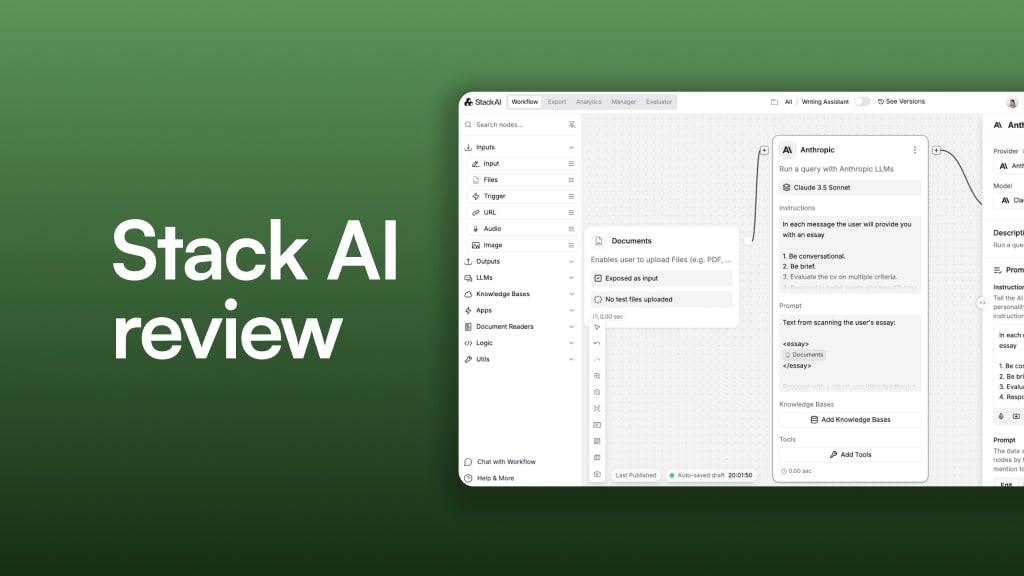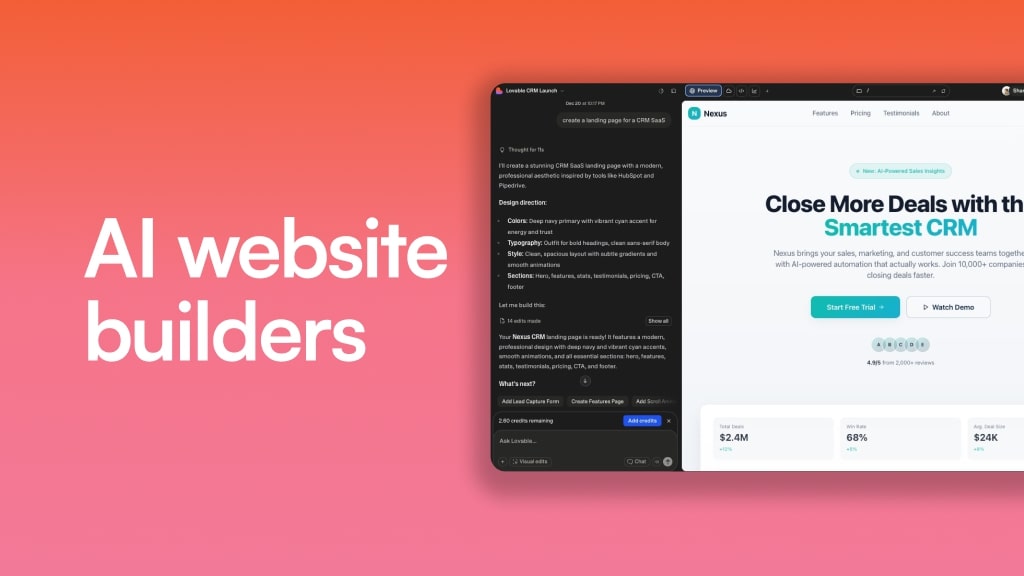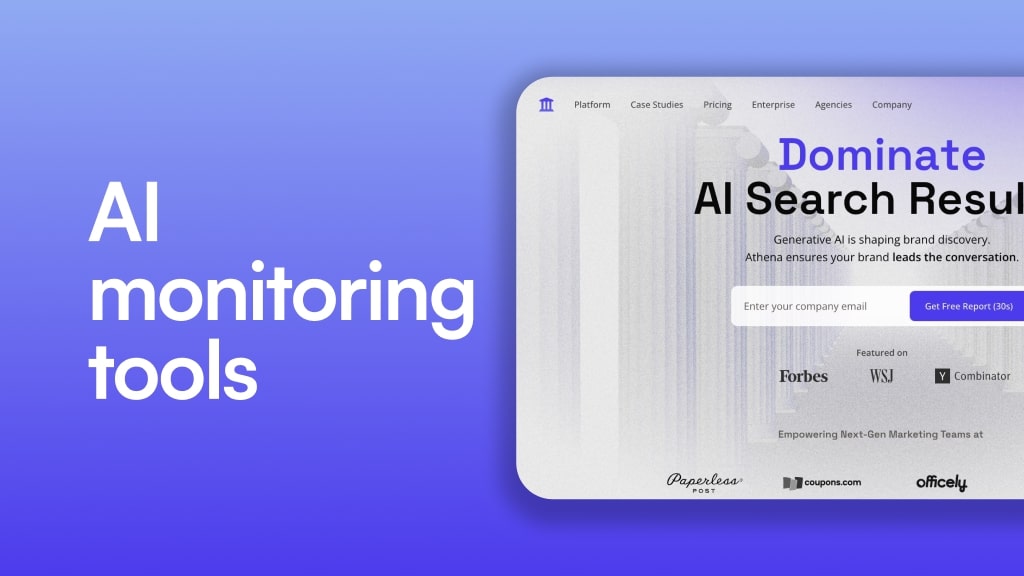There are so many AI agent builders that I’m about to lose my mind.
And if you're reading this, I'm sure you're aware of how many AI tools keep popping up.
It's hard to tell which ones are legit and which ones are just a ChatGPT wrapper someone vibe coded in an afternoon.
I don't review tools often, but every once in a while, something catches my eye.
And in this article, I want to give you an honest Stack AI review after using the platform for some time.
I'll break down who it's actually for (spoiler: not everyone), walk through the features that matter, and tell you straight up whether it's worth the enterprise price tag. Because while Stack AI has some seriously impressive capabilities, it's definitely not the right fit for every business.
I was pleasantly surprised by a handful of features though. There are some hidden gems in the tool, and I’m going to go over them.
Alright, no more rambling. Let’s get into it.
Who is Stack AI for?

Stack AI is an AI agent building platform that is designed specifically for enterprise companies. They have customers like HP, SmartAsset, Red Bull, IBM, and a ton more big brands.
So it’s not the best tool if you’re a small startup. But I did already write a blog article about my favorite AI agent platforms you can check out (any of those can be used for any size business).
Okay now that we know Stack AI is for the big guys, let me explain which type of companies will benefit the most.
Stack AI is great if your company has a lot of unstructured data sitting in different systems (and you want to make that data actually useful). If your team is constantly jumping between Salesforce, SharePoint, Snowflake, and a bunch of other tools just to answer one question, Stack AI can connect all those dots with AI.
From what I've seen reading through their customer stories, it's mostly great for:
- Finance and insurance teams who need to automate document-heavy processes. I’m talking like financial report reviews, analyzing credit risk, or process claims. These customers are using Stack AI to build AI assistants that can pull insights from large spreadsheets and documents in seconds. Their finance solutions and insurance solutions show some pretty specific use cases like automating underwriting decisions or fraud detection.
- Educational institutions are another interesting fit. MIT's entrepreneurship center uses it to build AI assistants for their students. What's cool here is that professors and program managers (not developers) are building these tools themselves. You can check out their education solutions to see how schools are using it for everything from personalized tutoring to automating administrative tasks.
- Healthcare organizations building physician co-pilots. These teams need HIPAA compliance (which Stack AI has), and they're using it to pull patient histories from EHRs or automate SOAP notes after patient visits.
- AI agencies and marketing teams. This one's close to my chest. Stack AI actually has a whole agency solutions page that I was pumped to find. Agencies are using it to automate client onboarding, create content generation workflows, and build custom AI tools for their clients without needing a dev team.
One thing I do wish is that I could integrate it with Google Analytics, which does limit some marketing use cases. But you can still pull data from your CRM, use the SerpAPI, and other marketing tools to create some pretty powerful automations.
But overall, the core idea here is that this platform can help non-technical people build AI workflows without having to get developers involved. It's the typical value prop of all the AI agent tools out there. So the use cases are quite broad.
With that, let's go over some of my favorite features that should give you a better idea of if this platform is right for you or not.
Stack AI’s popular features
Stack AI is a powerful tool. And normally what happens with these types of tools is that there’s a fairly steep learning curve.
But, one really cool thing about Stack AI is that you can just “talk” to the tool and have it build you an agent. I was actually blown away by this, so let me show you what that looks like in the first major feature, the Agent builder.
Agent builder
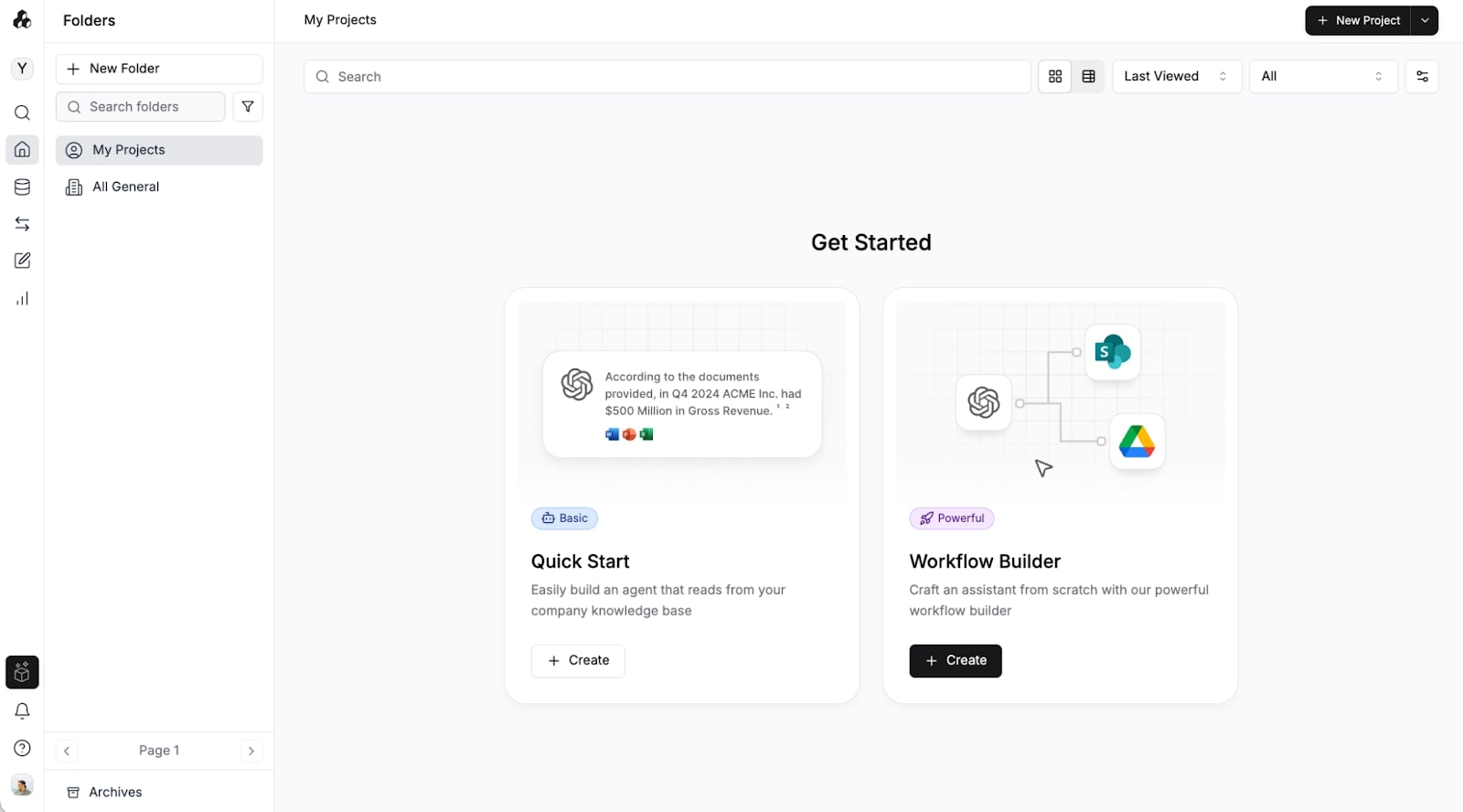
The Agent builder is where everything happens. And once you create your Stack AI account, you’ll be prompted to the screen above.
Here you can choose between going the quick start route or the custom builder route. I recommend first going with the quick start option because it will help you better visualize how the tool works.
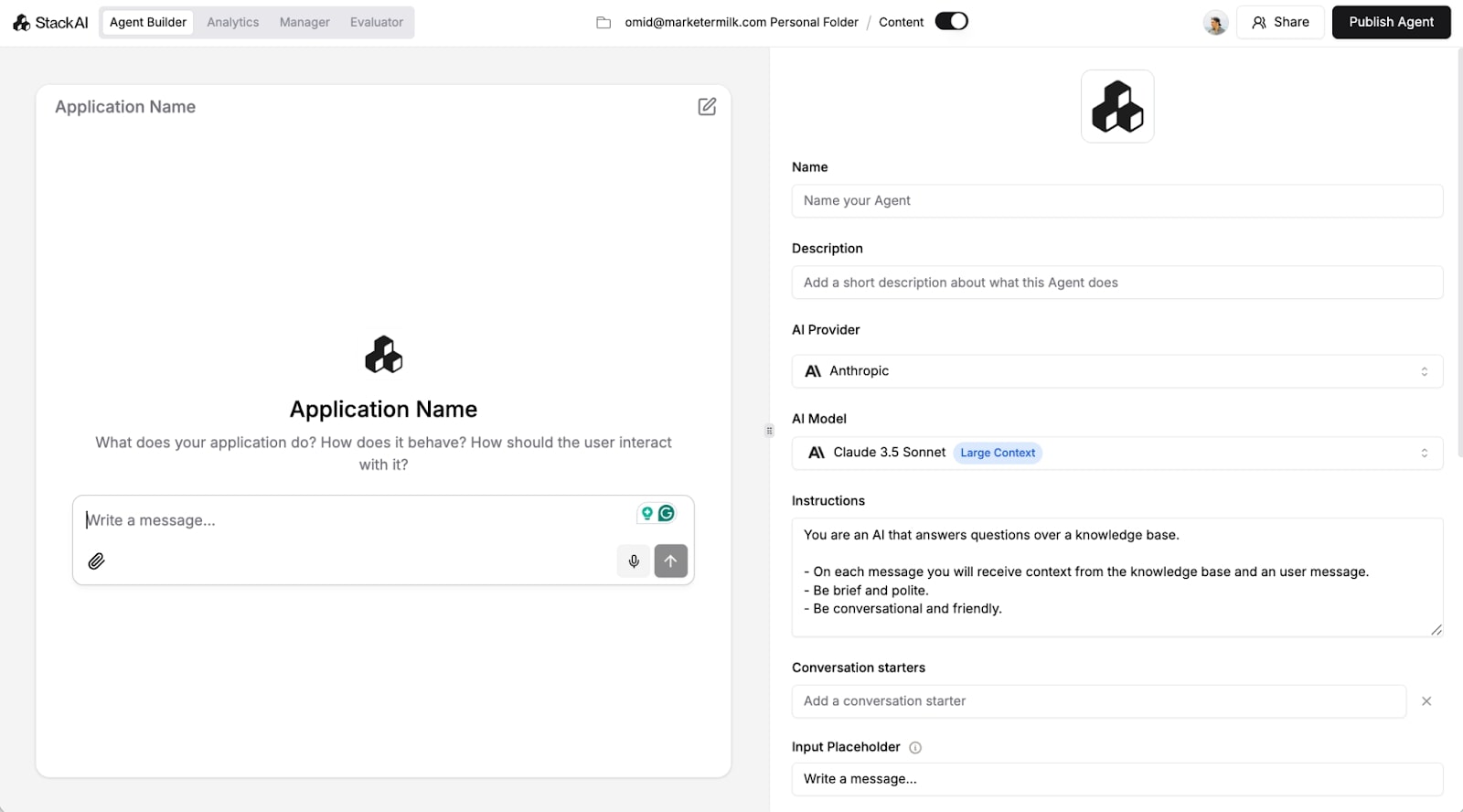
Here you can simply create your Agent by just describing what you want it to do. You can also select from different LLMs and specific models for your Agent to run on.
In this case, I want to create a content analyzer template for my marketing agency. I want the Agent to read a contract from a client and tell me what the terms are and if there’s anything I should pay close attention to.
There are tons of AI providers you can use, but I’m going to go with Anthropic:
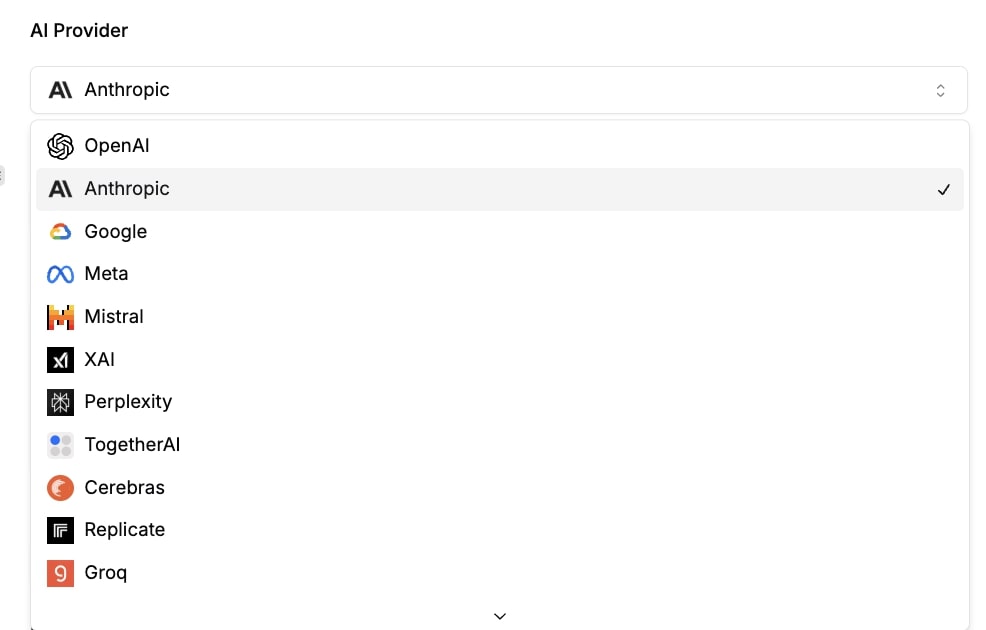
And there are also tons of models you can pick from (it will tell you how each one works):

While you chat with the tool, you can also bounce ideas back and forth on how to approach building the agent. I thought this was pretty cool because it’s like using ChatGPT to have a conversation while you’re doing something else in a different platform (except now it’s all in one tool).
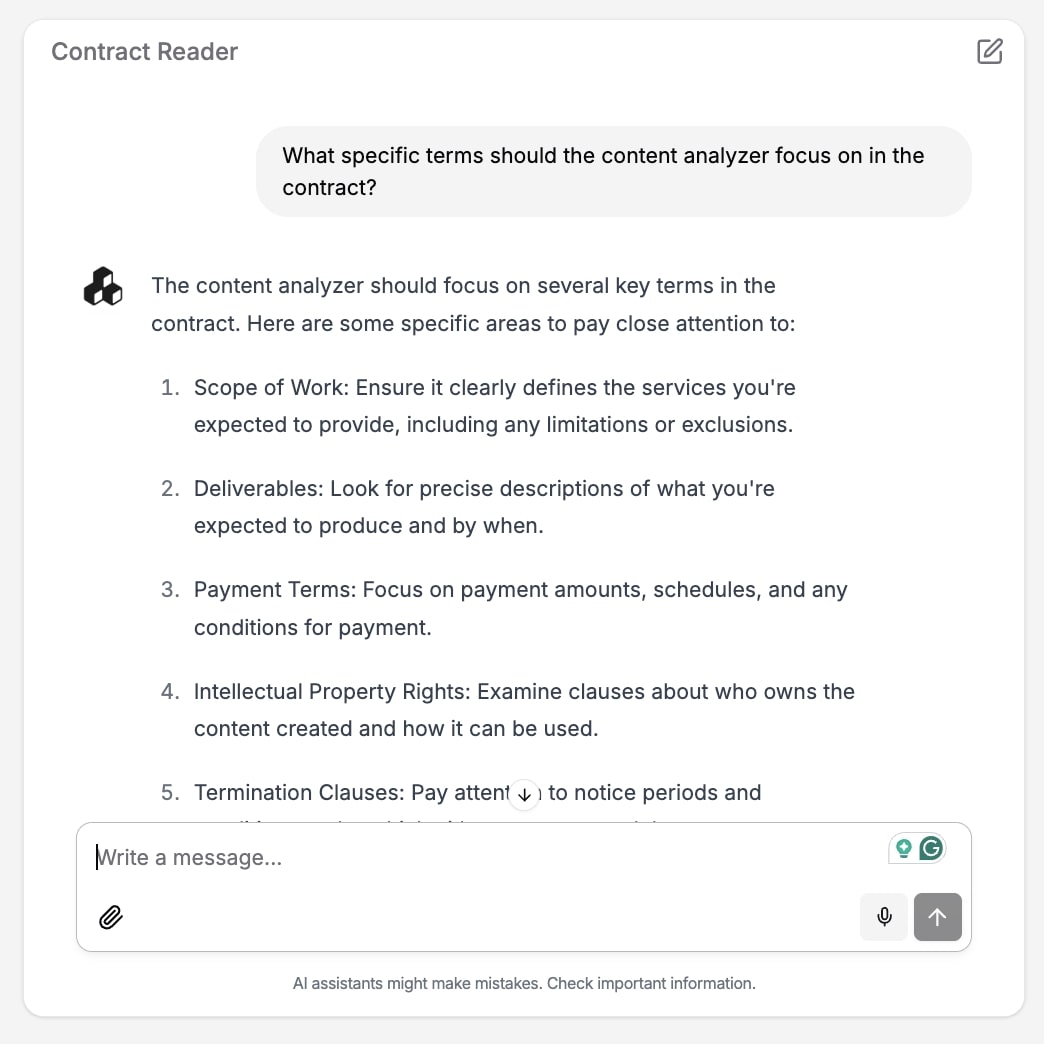
Once you spend some time configuring your agent, which is very similar to if you ever build a GPT app before, you can simply publish it and get a shareable link.
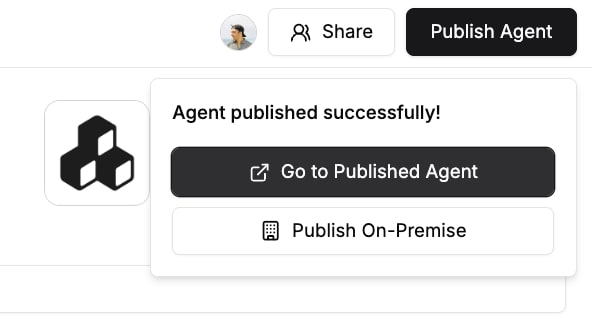
Now that the Agent is published, anyone with my link can open the site and start interacting with it.
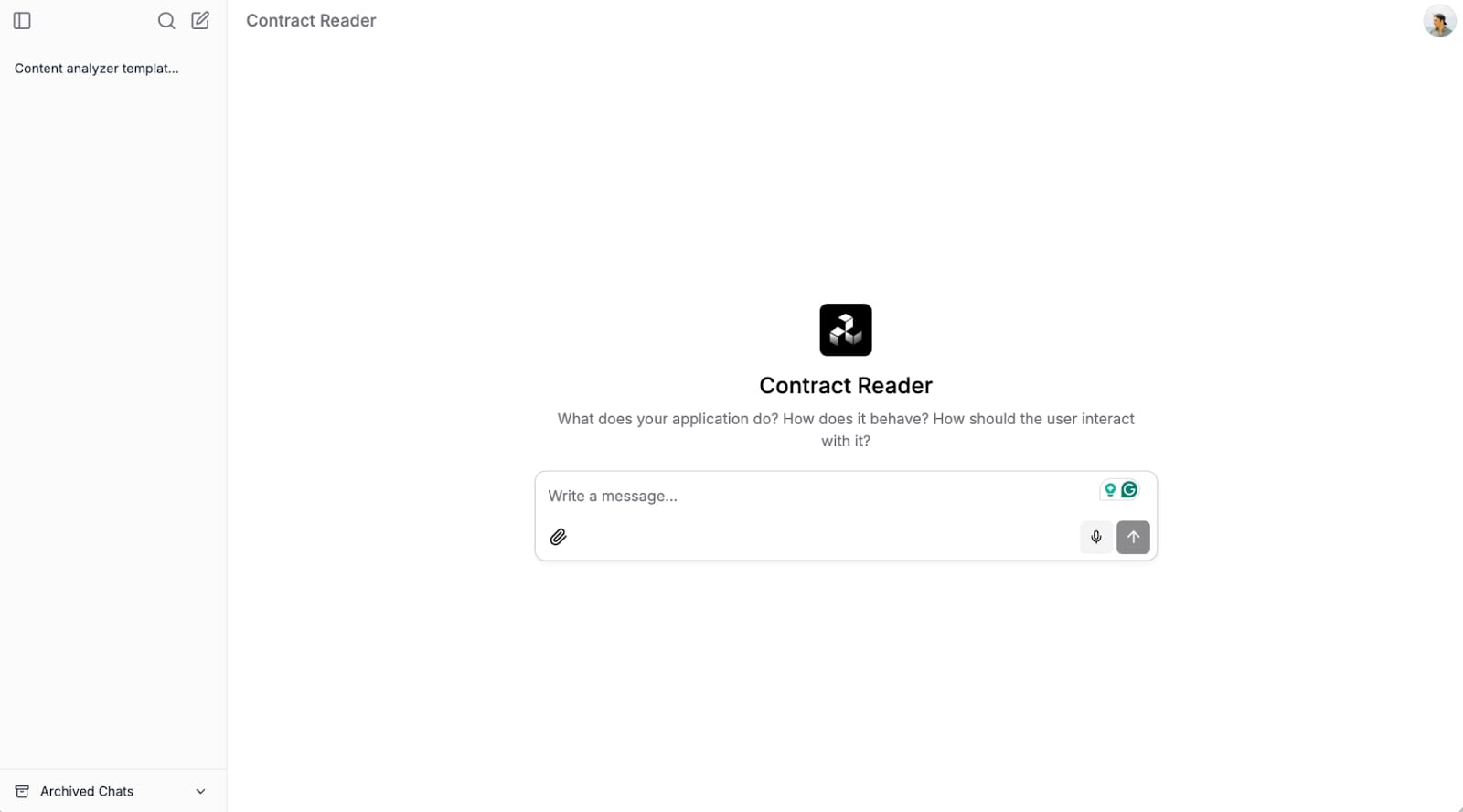
But let’s say this is too simple and you want to build something really powerful. Something that can integrate with existing tools you might be using and have automation features built into it.
This is where we go and create a project from the ‘Workflow Builder’.
Templates
This is where Stack AI starts to get interesting. When we start with the more powerful ‘Workflow Builder,’ we have options to start from different types of templates.
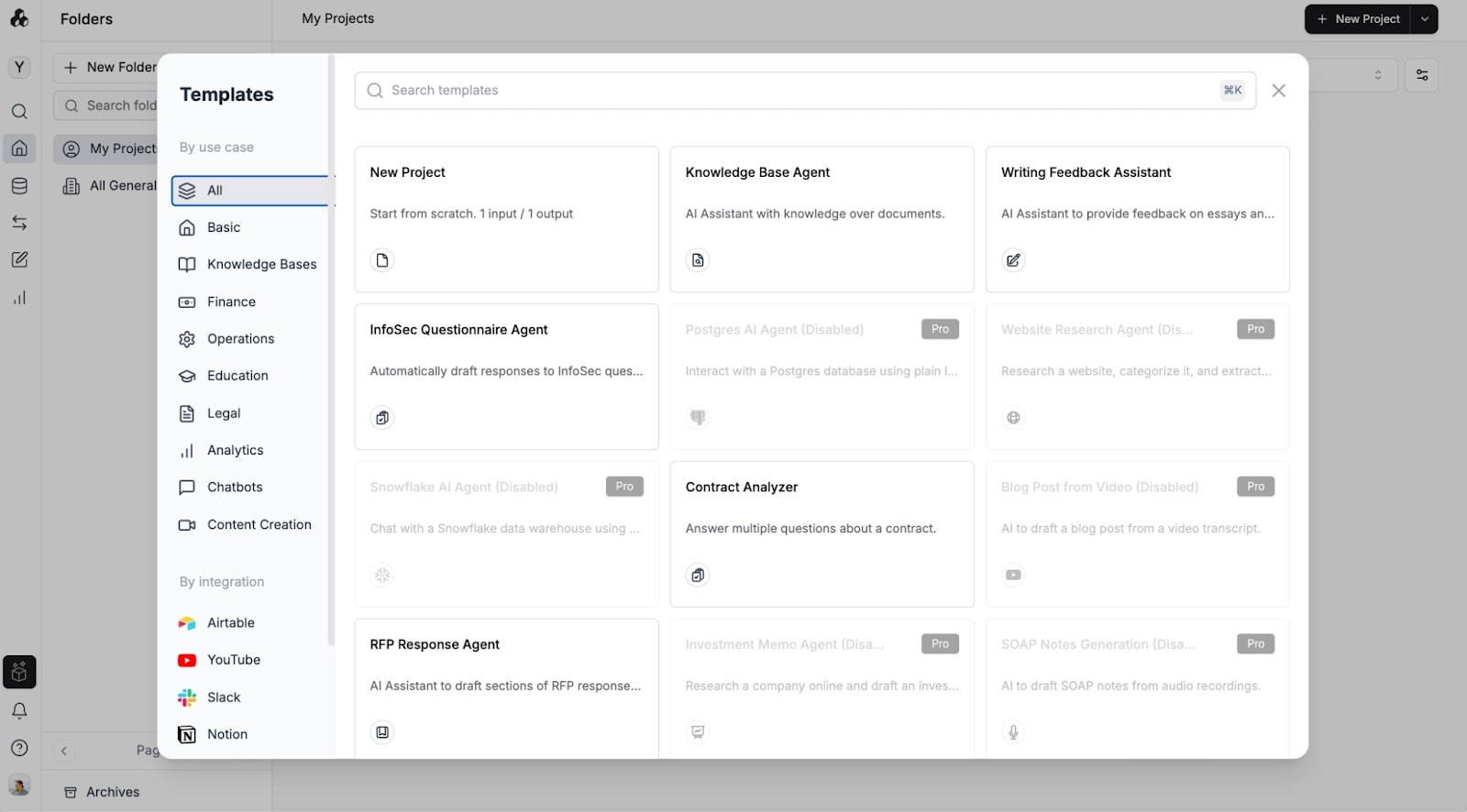
And when you select a template, you can see how it’s been built. This is great for two reasons:
- You can start with a template and expand and edit it.
- Or, you can analyze templates to reverse engineer how to build something from scratch.
In this case, I’m going to start with the “Writing Feedback Assistant” template:
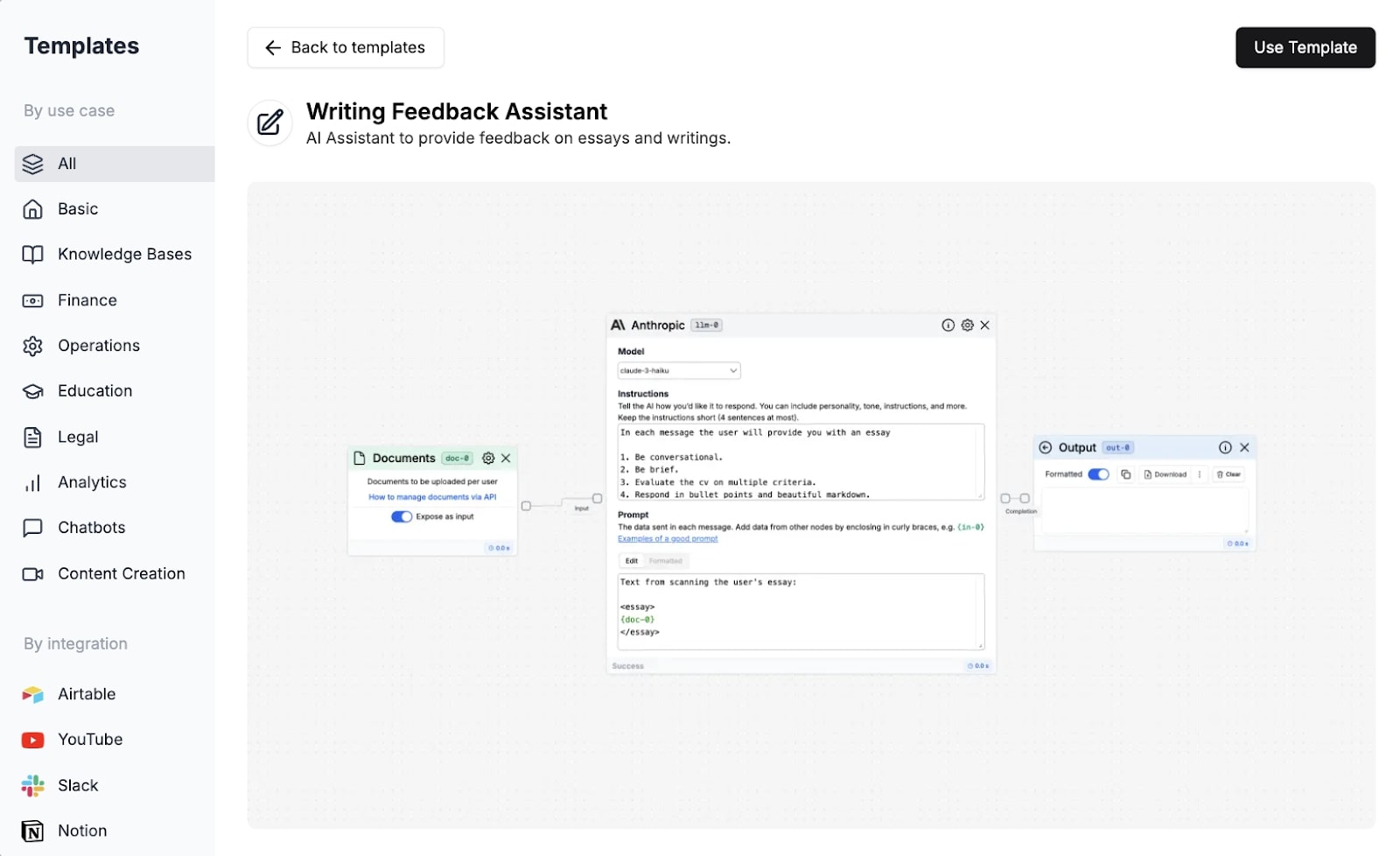
Once you select a template, you name it, and then you’re prompted to the visual Workflow builder. This is your canvas to build whatever agent you want. It’s very similar to one of my favorite AI agent builders, Gumloop.
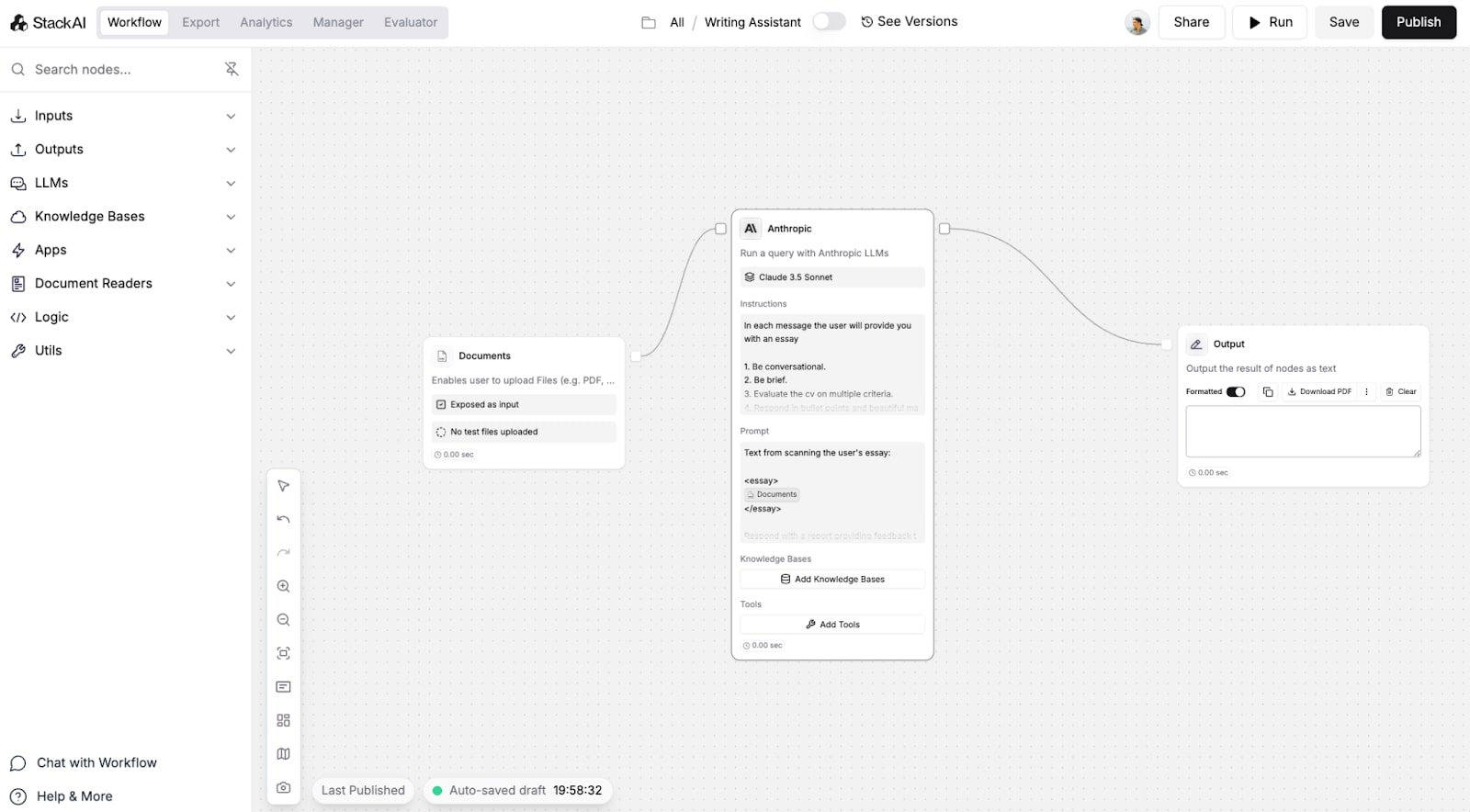
What’s really impressive about Stack AI is how smooth and clean the entire platform feels. The UI/UX just makes sense, and it’s so nice to look at and interact with. If you have tried n8n (probably the most popular Ai agent builder) in the past, and looked for an alternative, Stack AI is a breath of fresh air when it comes to design.
I will be honest though, even though the tool looks great, and is buttery smooth, there still is a learning curve.
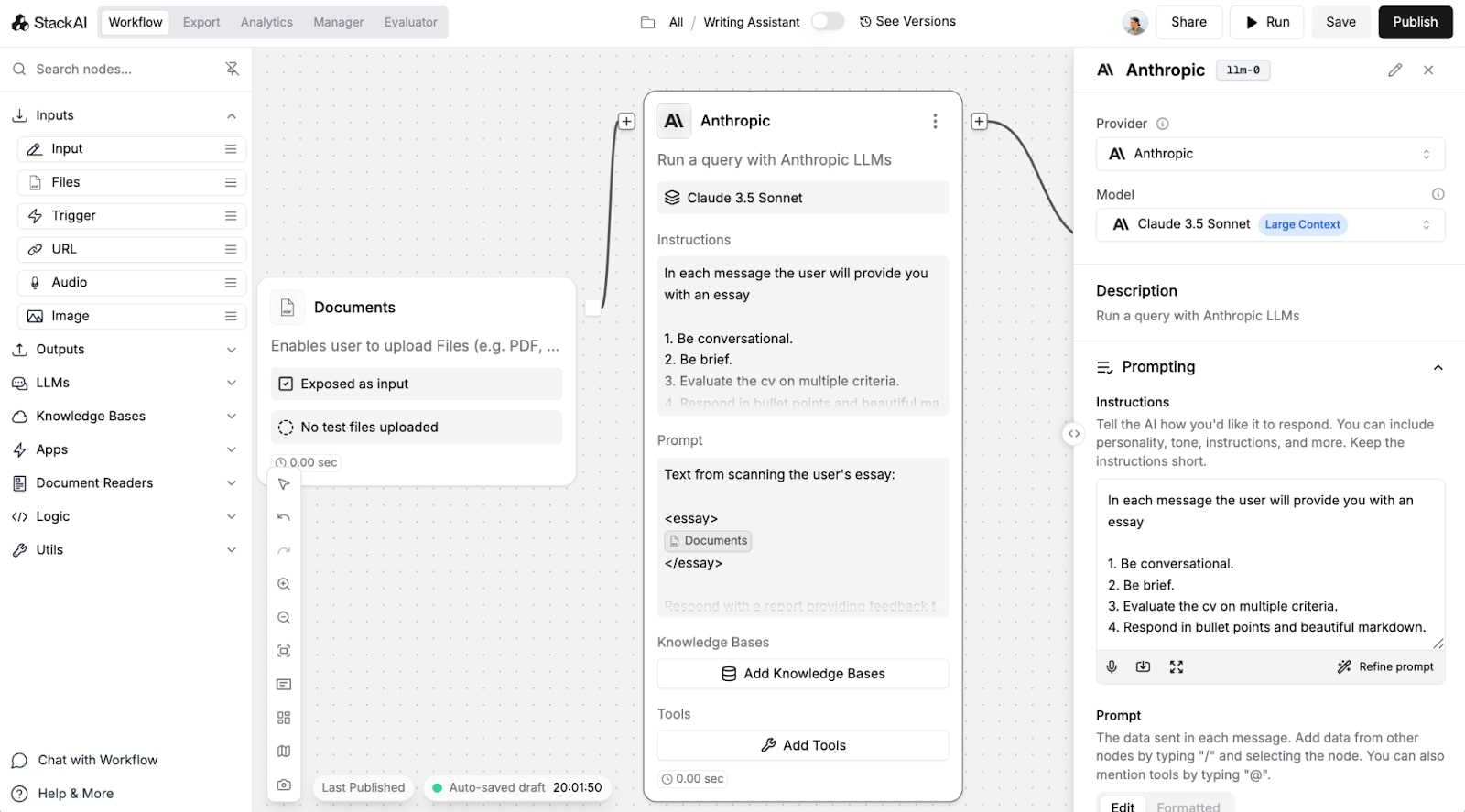
Don’t get me wrong, I love the UI. But I do wish that there was better onboarding. At least something that could guide me on how to to think about all the features and why they mattered.
Either way, the entire Agent and workflow builder experience is incredible. And there are a ton more features within it, so let’s talk about those.
Integrations
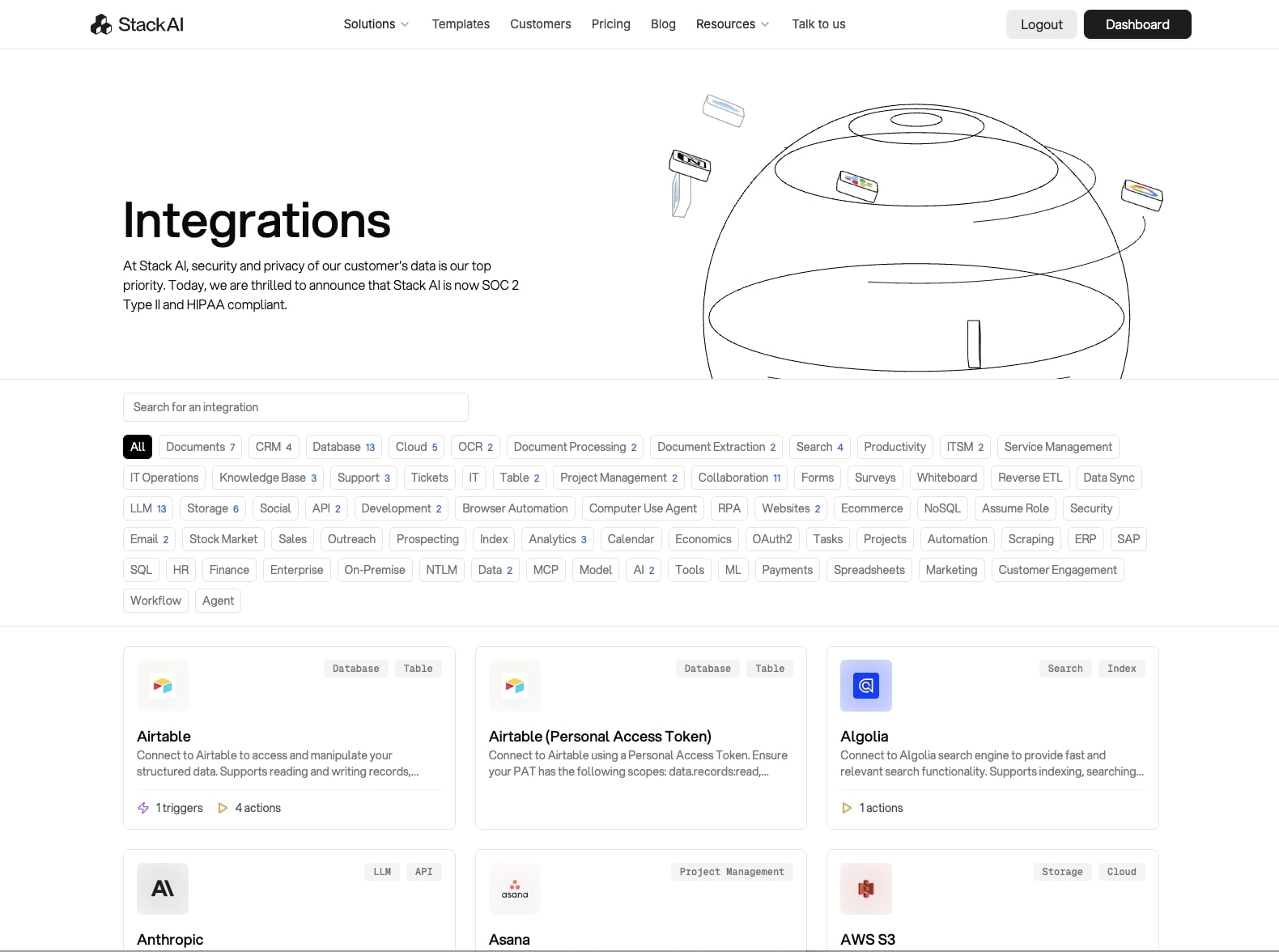
Stack AI has a ton of integrations. Notion, Airtable, AWS, every LLM under the sun, BigQuery, GitHub, Google Workspace, HubSpot, MCP, MongoDB, and whatever else can be integrated.
It’s actually insane.
Everything from a simple Google Spreadsheet to an entire backend database. Remember how I said in the beginning that this tool can be used for any industry? Ya, sky’s the limit.
What's really cool about how Stack AI handles integrations is that they are all accessible right from the workflow builder. Everything is right there in the left sidebar under "Apps."
When you're building a workflow, you just drag any of these apps onto your canvas as nodes, then connect them together to create your automation.
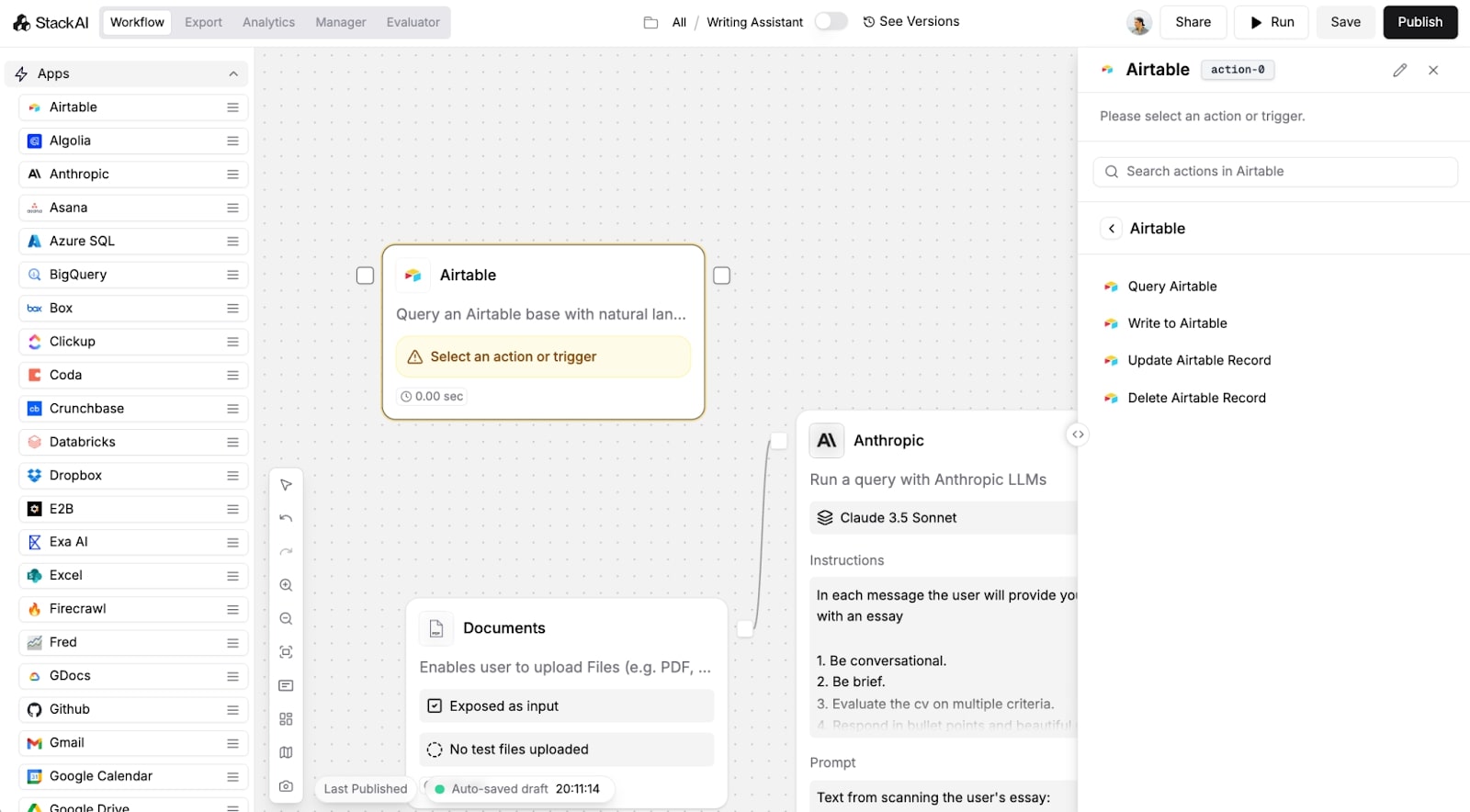
For example, when I drag the Airtable node onto the canvas, the right sidebar immediately shows me all the different actions I can take with it:
- Query Airtable (using natural language, which is wild)
- Write to Airtable
- Update Airtable Record
- Delete Airtable Record
The same goes for every other integration. Drag Google Calendar onto the canvas? You can create a new calendar or event. Drop in Slack? Query a Slack channel, read channels, send a message.
What makes this powerful is how you can daisy chain these together. You could have an AI read a document from Google Drive, analyze it with Claude or ChatGPT, pull relevant data from your Snowflake database, and then update a record in Salesforce in one workflow.
And don’t get me started with MCP. If you don’t see an app preloaded in the builder, you can call an MCP server anywhere in the workflow. What a time to be alive. Tech just keeps getting crazier and crazier (my head might explode).
Other customers, like on G2, also said how wild the integration library is. One user mentioned "the amount of adapters and connectors they have seems endless" and that they're impressed with how Stack AI adds support for new LLM models the same day they're released.
And the integration setup is also pretty straightforward. You authenticate once (usually through OAuth), and then you can use that connection across all your workflows. No need to keep re-entering API keys or credentials every time you want to use an integration.
Interfaces
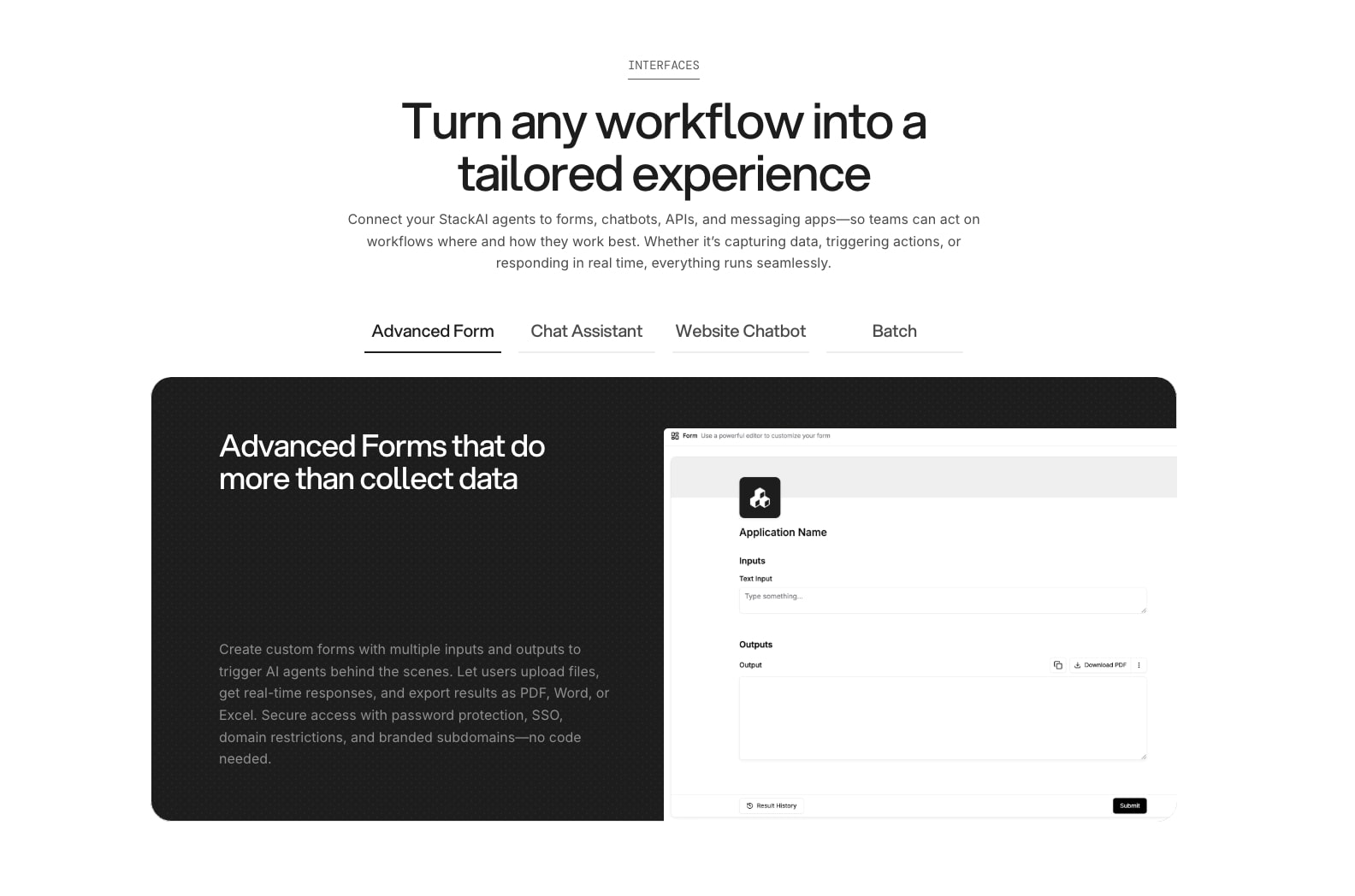
Once your workflow is ready (and least the V1), you need a way for your team to actually use it. That's where Stack AI's interfaces come in.
When you're done building your workflow, you just click the "Export" tab at the top of the workflow builder, and you'll see all your deployment options:
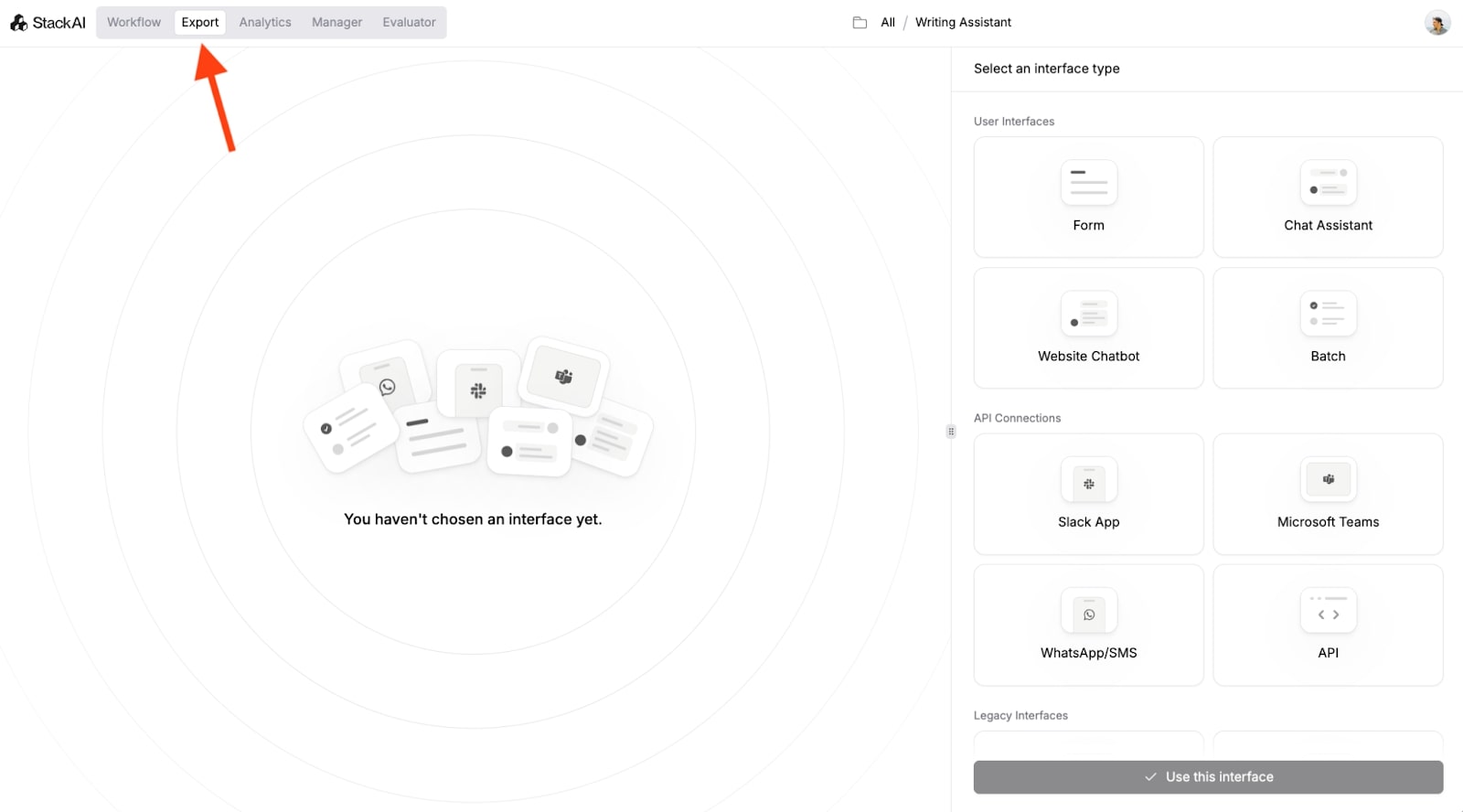
Stack AI gives you a bunch of different ways to deploy your AI agents:
User Interfaces:
- Form: This is great for structured inputs like loan applications or feedback forms. You create specific fields that guide users through the process.
- Chat Assistant: This is the standard chatbot interface (from the Agent builder quick start option we did earlier).
- Website Chatbot: This can be embedded directly on your website for customer support or lead generation (SO SICK).
- Batch: This can process multiple files or documents at once (like for analyzing customer reviews or support tickets).
API Connections:
- Slack App: Deploy your AI directly into Slack channels
- Microsoft Teams: Integrate with Teams for enterprise environments
- WhatsApp/SMS: Meet customers on their preferred messaging platforms
- API: For developers who want to integrate workflows directly into existing products
What's cool is your AI agent can literally meet people where they already work.
The chat interfaces are probably what most internal teams will use. They're clean, you can brand them, add custom instructions, and control exactly what data users can input (like I showed earlier with my contract analyzer).
And if you're more technical, those API endpoints let you integrate these AI workflows directly into your existing products. So that AI assistant you built could live right inside your company's internal tools or customer-facing app.
How much does Stack AI cost?
This has all been cool and dandy, but what about price. These AI tools usually aren’t that cheap. And given that Stack AI does advertise themselves as an enterprise tool, it’s mostly likely not going to be your regular $99/month SaaS.
Let’s look at the price.
Stack AI pricing plans
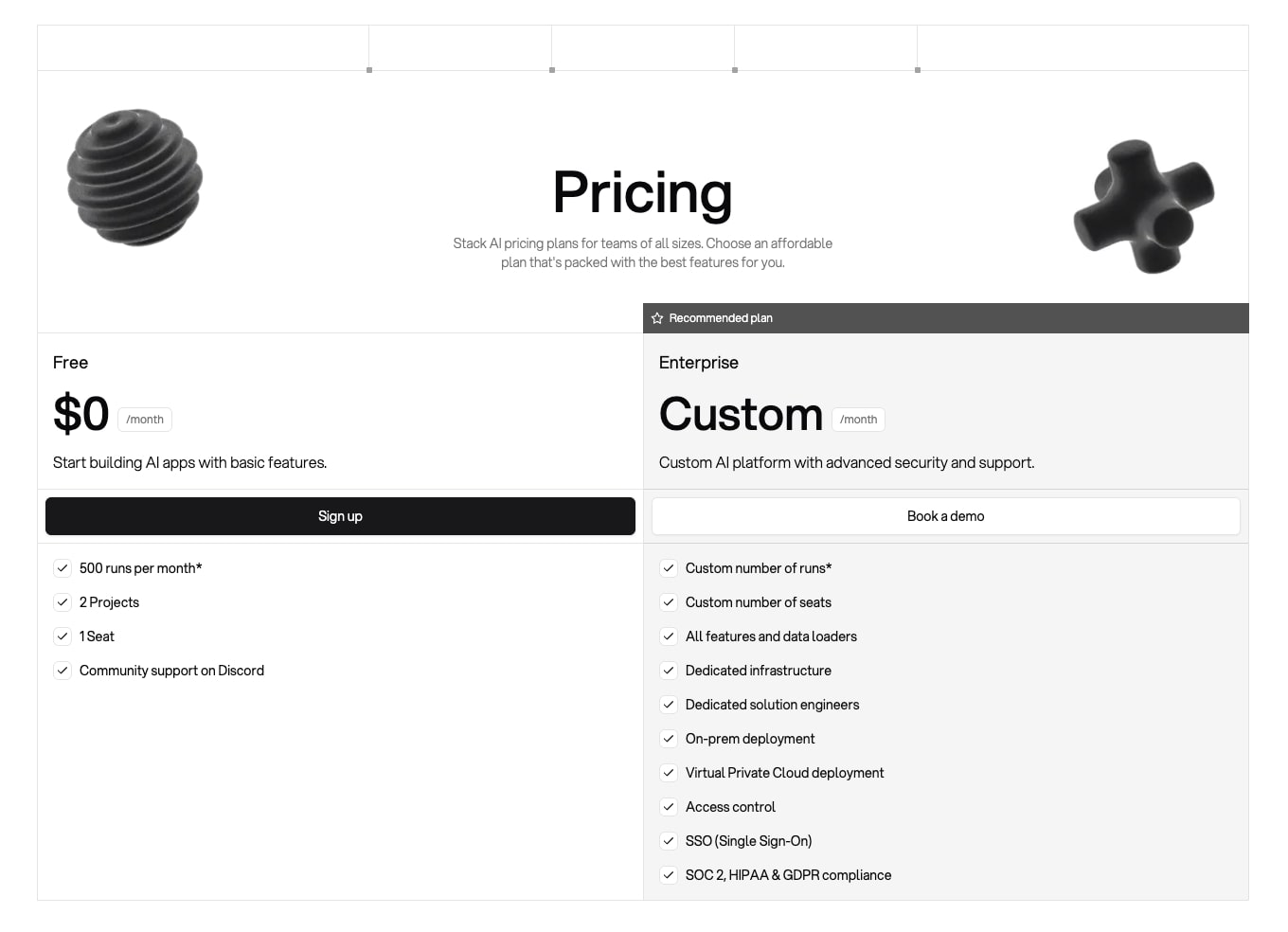
Here are Stack AI’s pricing tiers:
- Free: $0/month, comes with 500 runs per month, 2 projects, 1 seat, community support on Discord.
- Enterprise: Custom pricing, comes with custom number of runs, custom seats, all features and data loaders, dedicated infrastructure, dedicated solution engineers, on-premise deployment option, VPC deployment, access control, SSO, and SOC2/HIPAA/GDPR compliance.
Yeah, you read that right. There's just two tiers, Free and Enterprise. No middle ground here (at least for now).
The free plan is actually pretty generous for testing. You get 500 runs per month which is enough to build some workflows and see if the platform works for you. Plus access to the major AI models and basic integrations.
But if you want to actually use this for your business, you're jumping straight to Enterprise pricing. And they don't list prices, which usually means "if you have to ask, you probably can't afford it."
This pricing structure makes sense given their target market. They're not trying to compete with self-serve AI tools. They're going after companies that need compliance, dedicated support, and can drop serious cash on enterprise software.
For the most detailed breakdown of what's included in each plan, check out their pricing page.
Stack AI customer support
Support is something I always pay close attention to when it comes to software.
Since Stack AI is enterprise-focused, their support is probably as hands-on as it gets. Enterprise customers get dedicated solution engineers and forward-deployed engineers who literally help you build your workflows.
For free tier users, you get community support through their Discord server. They also have a solid self-serve knowledge base. Their docs are comprehensive, they have an Academy with tutorials and courses, and they also have a blog with use cases and updates.
Based on G2 reviews, users consistently mention the support team being "exceptional" and "responsive." One reviewer mentioned getting same-day support when new LLM models drop, which is pretty impressive.
The big difference here is the support model. Free users rely on community and self-serve resources. Enterprise customers get white-glove treatment with dedicated engineers. There's no middle tier, so if you need official support beyond Discord, you're looking at Enterprise pricing.
But for an enterprise tool, this level of support makes sense. When companies are dropping serious $$$ on software, it’s expected to get great support in return.
Stack AI’s scalability (and security)
When you're building AI workflows for an enterprise you need to make sure it can scale and it’s safe (not only for your internal team but for your customers as well).
When it comes to scalability, Stack AI handles growth through the cloud. You can start with a few workflows and scale to hundreds across multiple teams. They offer:
- Custom infrastructure for large deployments
- On-premise deployment options
- Virtual Private Cloud (VPC) deployment
- Support for processing everything from hundreds to millions of documents
When it comes to security, Stack AI likes to flex a little. They have all the compliance certifications enterprises need:
- SOC2 Type II compliant
- HIPAA compliant for healthcare data
- GDPR compliant for European operations
- Data Processing Agreements with OpenAI, Anthropic, and other AI providers
- No training on your data (your information stays yours)
- Role-based access control and SSO for Enterprise
- Full audit logs for tracking everything
The combination of scalability and security is what makes this an actual enterprise tool versus just another AI wrapper built on Lovable (no hate). You can build workflows knowing they will scale with your business and that your sensitive data is protected. Check out their security page for all the compliance details.
Stack AI pros and cons
This wouldn’t be an official Stack AI review without a pros and cons list. After spending some time with the tool, here’s my honest opinion on what I like and don’t like.
Stack AI pros
Here’s what I like about Stack AI:
- UI/UX is fantastic, I can’t get over it
- The no-code drag-and-drop builder is buttery smooth
- Insane number of integrations (100+ connectors)
- Enterprise-grade security and compliance out of the box
- Support for every major LLM provider (no vendor lock-in)
- Generous free tier for testing (500 runs per month)
- Pre-built templates
- Multiple deployment options (chat, forms, API, Slack, etc.)
Stack AI cons
Here are some things I wasn’t too fond of:
- Unknown price jump from free to Enterprise (no middle tier)
- No Google Analytics integration for marketing workflows
- Overkill if you just need simple automations
- Free tier only gets Discord support
- Some integrations can be confusing to set up
- Missing some popular marketing tools like social media schedulers
Overall, it’s great. I’m looking at things more from a marketing lens (because that’s what I do). But when it comes to other industries that we talked about in the first section of this article, it’s a great fit for those niches.
The only thing is the unknown price. I imagine they might move down market eventually, but going enterprise first does make sense (and I can see why they did it).
TLDR: My final thoughts
Overall, Stack AI is built for enterprises that need to turn their messy data into actual AI workflows. It's not trying to be everything for everyone, and that focus is what makes it powerful.
Stack AI makes sense if:
- Your team is bouncing between Salesforce, SharePoint, Snowflake, and a bunch of other tools just to accomplish one main task (automate it!).
- You're trying to build an internal AI agent in the finance, healthcare, or education space (where compliance really matters).
- Non-technical people on your team need to build AI workflows without taking time away from your devs.
- Your organization is serious about AI adoption internally, and you have the budget for enterprise software.
The thing is, Stack AI isn't playing in the same game as most AI tools. While everyone else is racing to the bottom with $49/month plans, Stack AI went straight for the enterprise market. And honestly, it makes sense. The companies using this (HP, IBM, MIT) need way more than just another ChatGPT wrapper.
But that enterprise focus is also its biggest limitation. If you're a small startup or agency founder (like myself), you're stuck between a generous but limited free tier and custom enterprise pricing that's probably out of reach. In that case, it would be worth looking into a platform like Gumloop or n8n.
Is Stack AI worth it?
✅ Yes, if you're an enterprise company that needs secure, compliant AI automation across multiple departments. The visual workflow builder genuinely makes AI accessible to non-technical teams, and the integration library is pretty wild. This is one of the few platforms that can handle everything from simple chatbots to complex multi-system automations.
❌ No, if you're a small business looking for affordable AI automation or just needs a simple workflow. There is a decent free plan, but no accessible paid plan. And there are plenty of other tools that offer middle-tier pricing for growing companies.
What makes the platform unique?
Stack AI stands out because it's a true enterprise-level AI agent builder. While other platforms add "enterprise features" as an afterthought, Stack AI built everything around enterprise needs. SOC2, HIPAA, GDPR, and all the other acronyms big tech cares about are taken care of.
The UI is also amazing (one of my favorite parts of the tool). Most enterprise software looks like it was designed in 2003, but Stack AI's interface is buttery smooth, modern, and actually enjoyable to use. The fact that you can "chat" with the platform to build workflows is nice too.
It's a powerful tool. And I recommend you sign up for the free plan and play around with it for yourself. Even if you're not ready for enterprise pricing, the free tier gives you enough to build some real workflows and see if you like it. Who knows, maybe you'll build something so valuable that the enterprise pricing begins to make sense.
Get the weekly newsletter keeping +30,000 marketers in the loop.










